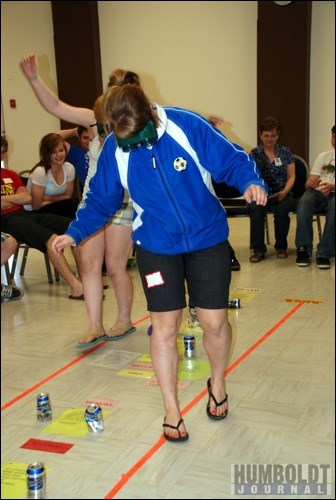Another PARTY at the Humboldt Uniplex this week was a huge success.
The second of two Preventing Alcohol and Risk-related Trauma in Youth (PARTY) program sessions took place at the Uniplex on May 19, this time hosting driver's education students from Humboldt.
Every year, led by Safe Communities Humboldt and Area, local partners come together to put on the PARTY program.
The day-long event for Grade 10 students focuses on educating youth on the consequences of their decisions, said Carol Marriott, Safe Communities' program co-ordinator.
Some of the lessons are to drive sober, buckle up, get trained, think first and wear the gear.
"Our mandate is injury prevention," said Marriott, pointing out the PARTY program fits in their mandate.
"People change through suffering or education... a little more information helps them (make good decisions)," said Marriott.
The day started with a mock vehicle collision, to demonstrate to the students what really happens in the aftermath of a crash.
The students were impressed with how realistic the mock crash was - it involved Humboldt and District Ambulance Service, the Humboldt Fire Department, and the Humboldt RCMP - and many said it was their favourite part of the day.
"When the ambulance first came, it felt real," said Treyton Luker, Humboldt Collegiate Institute (HCI) student.
After the mock crash, the students visited four different rooms to learn about what happens after a collision.
The first room was a slideshow presentation by Const. Trevor Scott of the Humboldt RCMP.
The slideshow consisted of photographs from real collisions to show students the reality of making bad decisions.
One of the major points Scott stressed to the students was the importance of seat belts.
"You have a 90 per cent chance of survival wearing your seat belt versus not wearing your seat belt," said Scott.
Scott also explained the police are not on the highways pulling people over to be bullies.
Automobile collisions are something that can be prevented and the police just want to keep the public safe, he noted.
"If everyone followed the rules of the road... there would be zero crashes," said Scott.
The second room the students went to was a demonstration by nurses Jackie Flavel and Kendra Wempe of what goes on in a hospital emergency room after a crash. They showed the process from the victim arriving conscious in the ambulance to going into cardiac arrest.
After seeing that demonstration, the students moved to the next room where Linda Salikin , a mother of a crash survivor, and Erin Plamondon-Braun, a mental health worker, explained different mental and physical health problems people may have after surviving a collision.
"The choices we make don't seem that big of a deal, but they affect everyone," said Salikin.
The students were also shown a video of teenagers telling their stories about how texting and driving is dangerous.
The students were shocked at how dangerous texting and driving can be.
"Texting is as stupid as drinking and driving," said Aaron Kosokowsky, HCI student.
"That's how illogical texting and driving is," said Plamondon-Braun.
"Would you close your eyes for six seconds? No. But when you text and drive that's just what you do."
The students also had the opportunity to attempt to get into a wheelchair from a different chair without using their legs and trying to put on a shirt using only one arm.
The last room the students visited in the morning was the addictions room, where they learned about the effects of alcohol on your vision, motor control and decision-making skills.
Addictions counsellor Leanne Garing let the students use beer goggles to give them an idea of how their vision is impaired after drinking alcohol.
In the afternoon, the students visited local funeral homes and listened to two survivor speakers, Cutler Lange and Brenda Schrader, who shared their stories with the students.
Every year, Marriott sees how the PARTY program affects the students.
Marriott gives the students a questionnaire before and after the program.
"There is a 75 to 78 per cent increase in awareness (after the program)," said Marriott.
"Having all that information may make a difference."
The information seemed to make a difference with many of the students.
"There was a lot of review but a lot of new information," said Kosokowsky.
"They should keep the program going... it's very educational."




